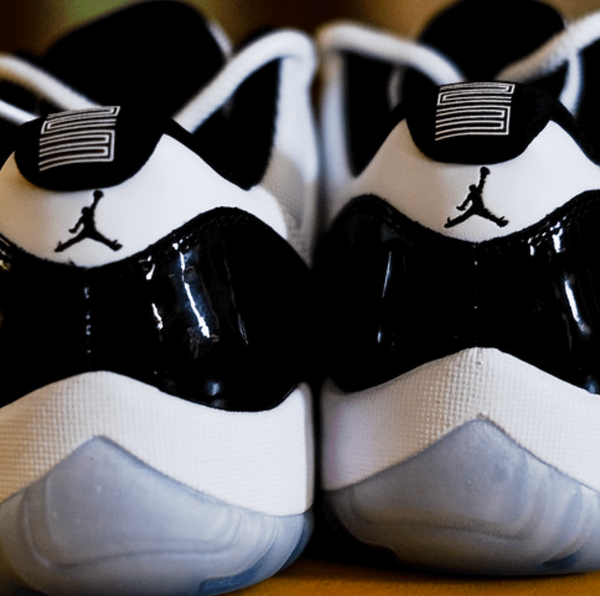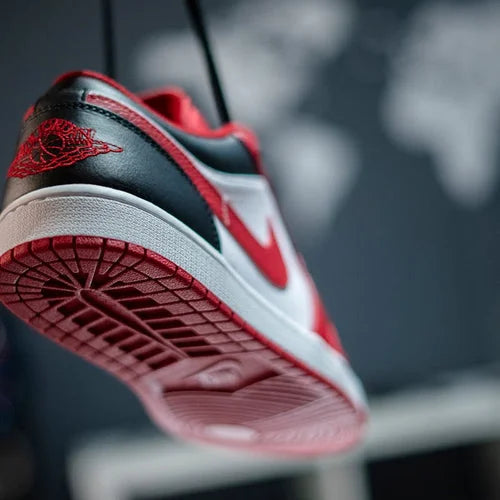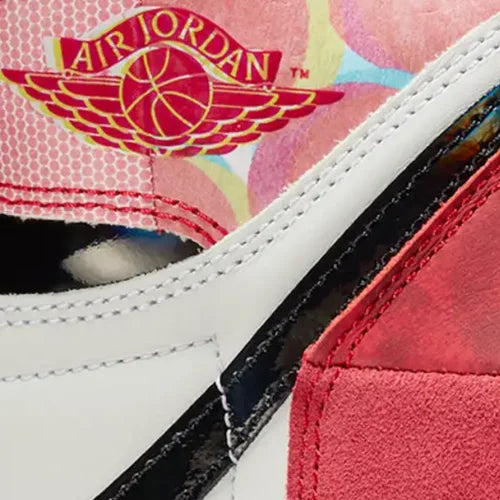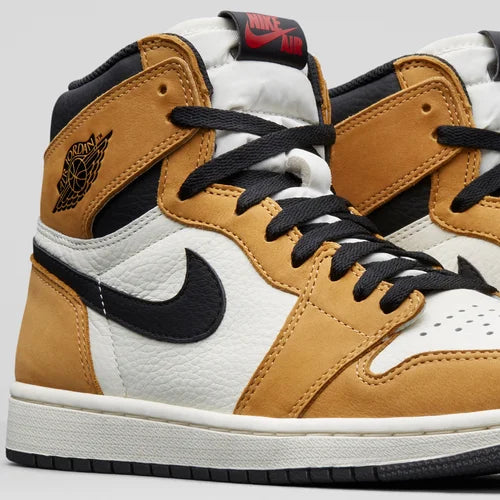How to Tell if Jordans Are Fake in 2025?

Air Jordan is a line of basketball footwear produced for Michael Jordan in 1984. Nike released the shoe to the public 1985, when annual sales totaled $126 million.
The "Jumpman" logo is a signature feature of the Air Jordan brand by Nike. It was inspired by a photograph of Michael Jordan before he played in the 1984 Summer Olympics.
Air Jordans have become a status symbol and a staple in street style. The Average Jordan retails at $145, so many wish to find a good deal to save money. Remember that the high retail price is justified by the quality and attention to detail. Looking for the cheapest price out there might get you a pair of questionable-quality fake Air Jordans.
How can you tell if Jordans are fake? Our detailed guide helps you distinguish between real and fake Jordans so you can avoid spending money on counterfeit footwear.
Table of Contents
[ open ]Inspecting the Box

The Air Jordan authentication process starts with examining the shoe box closely. Nike produces sturdy boxes made of quality materials to protect footwear. In addition to its protection aspect, the shoe box is essential for branding.
The material, colors, and logo are the points of interest in the first step of the authentication process.
Box Material and Color
How can you check if Jordans are real by analyzing the box? First, the original pair comes in a sturdy box of quality cardboard. Nike doesn't compromise when protecting the shoes for transport and storage. On the other hand, counterfeit products come in a box made of cheap material. Therefore, you might notice box damage.
The original box has the famous "Jumpman" logo on the top, and a smaller version of this logo is present on the side. Another indicator of the original box is the color quality. The package should have an intense color without faded spots, which is a sign of a poorly done counterfeit box.
Box Logo and Manufacturing Sticker

To inspect the box further, we recommend checking the manufacturing sticker and logo as represented above in Air Jordan 11 Jubilee. While counterfeiters put a lot of effort into creating a replica of the original sticker, the differences are apparent. Looking at the real Jordans vs. fake sticker design, we notice that the elements are positioned differently.
The sizing chart, official website, and QR code have different positions. Of course, the font differs between fake and real stickers. The fake manufacturing sticker has bold letters, especially in the pricing, where the black letters stand out against the white background.
Inspecting the Jordan Shoes
When we finish inspecting the shoe box, the next step includes checking every shoe detail. We will compare the overall design, heel, swoosh logo, Air Jordan wings logo, insole, and size label to spot fake Jordans.

The Overall Look Method
Analyzing the shoe's overall look reveals the potential signs that indicate a fake pair of Air Jordans. The first thing we can spot is the low-quality stitching, which is apparent in the Swoosh logo. The seam that goes right through the swoosh is straight and perfectly executed. It is stitched deep in the material, indicating good quality.
Conversely, the fake Jordan shoe has low-quality stitching, which can be recognized by its uneven look. It does not form a straight line through the swoosh and isn't stitched deeply into the material.
The Heel
We turn the shoe to analyze the heel for the next step. How can we tell if Jordans are fake at one glance? We need to examine the heel stitching. As the swoosh logo continues toward the heel, it forms a line.
A small heel tab covers where the stitches meet and should have two stitching lines. Fake models have only one stitch, and the material is poorly cut. The fabric for the original pair is cut with high precision, with streamlined seams and quality stitching.
The Swoosh
When we're done with the heel, we move to the sides to compare real vs. fake Jordans further. Nike's swoosh logo is a signature feature used to brand its products. Counterfeiters don't seem to do an excellent job of copying the logo. We have seen this in other Nike products and confirm that copying the exact details is challenging without sophisticated machinery.
How to spot fake Jordans by looking at the Swoosh logo? The shape is different, featuring a less pronounced curve that makes the swoosh look thicker at the top. On the other hand, the real pair has a pointy top and curvier shape, giving the look of an unethical Nike swoosh logo.
Next, the edges of the cutout can reveal if high-precision techniques were used. Nike uses sophisticated cutting machines so the edges will look precise. Also, the material will lie flat and have a seamless look.
The Air Jordan Wings Logo

This is the Air Jordan 1 Bred Toe logo above. The branded logo is another point of interest when inspecting shoes to determine if they are genuine. At first glance, the real and fake Air Jordan logos look identical. But if you look up close, you can notice the difference. How do you spot fake Jordan shoes just by analyzing the logo? While the counterfeiters did an excellent job with the graphics, they missed other crucial details.
- The logo is embossed deeper into the material for the real pair, which gives it depth and distinctive texture. On the other hand, the fake logo is stamped shallowly on the surface.
- Another sign that indicates counterfeit is the poor quality embossing. The original has a bold black logo that stands out well against the leather. However, the fake pair appears faded, which is more apparent on the trademark stamp.
- As we observe the Air Jordan wings logo further, we notice a difference in the font. Obviously, the counterfeiters couldn't copy the exact font used in the original. The fake Air Jordans have the letters very close; the letter style difference is apparent.
How do you tell if Jordans are fake by analyzing the logo positioning? The logo is stamped close to the heel stitching in the fake pair and looks odd. Moreover, the original pair looks harmonious thanks to the perfect positioning.
The Insole Logo
After inspecting the shoe exterior, it is time to move to the insole. Analyzing the Nike Air logo printed on the insole provides essential insights for determining real vs. fake Jordans. The thing to consider is the printing quality. Original Air Jordans feature high-quality print, as this part of the shoe experiences frequent wear and tear. The color makes a bold contrast without any faded spots. On the contrary, the fake pair can have low-quality logo prints and faded areas.
The font is another meaningful sign you shouldn't overlook. The letters can be thinner or thicker than the original and have different shapes. Lastly, the original's positioning of the letter "E" is precise. The bottom of this letter is seamlessly integrated into the swoosh logo, a design that counterfeiters often overlook when copying.
The Stitching

How can you spot fake Jordans in one step? You can do this by inspecting the stitching. Look closer at the Air Jordan 1 Rookie Of The Year stitching above. Nike uses sophisticated machinery in the production process to ensure high quality, which ensures the footwear will last long.
On the contrary, counterfeiters are looking for fast ways to earn money. They won't invest in good equipment, which results in poor shoe quality. The fake Air Jordans have shorter and uneven stitches that indicate they have been produced with a basic machine. The thread is thinner, signaling that forgers use cheaper materials.
The Size Label

The size label is another feature that can reveal whether the product is real or fake. The counterfeiters did a good job of copying the overall design, having the exact element placement as the original. However, as we inspect the label further, we can reveal inconsistencies.
The most apparent difference is how the label is attached to the fabric. The original label is framed, while the fake one is directly sewn onto the material. Also, we can spot a difference in the "Jumpman" logo design, which lacks precision in the counterfeit label.
The Insole
We have covered the insole logo in this guide and will now analyze its quality. The original insole is crafted from high-quality foam with a ridged surface that provides comfort. On the other hand, the fake pair has thinner and flat insoles.
When you turn the insole upside down, it should be light blue, and any variation in tone could indicate a counterfeit product.
How to Spot Fake Jordans Listings Online

You will shop around if you want the best deal for your money. However, this is tricky since you can quickly end up with a fake pair. To avoid being scammed, be very careful with the listings. In addition, we share a few aspects that help you assess the listings and determine if they are genuine products.
Unusually Low Price
When purchasing original Nike shoes, the price should match this brand. Checking the market price for new and second-hand Jordans would be a great starting point. Nike is a reputable brand that provides quality and exclusive craftsmanship, and the price reflects that.
A meager price that doesn't match the market price for a pair of Jordans can indicate counterfeit products. While counterfeiters copy the design, they don't have the technology to replicate the same quality. If a brand new pair is selling for less than $100, this indicates a counterfeit product.
Missing or Unclear Images
A seller offering a genuine product will not hesitate to provide as many photos as needed to attract buyers. After all, their product is original, and there is no reason to hide anything. The seller will not provide detailed photos of counterfeit products, so they won't be caught. Scammers provide blurry and low-quality images, so you can't inspect the details and assess the originality of the footwear.
Another case with counterfeit footwear is displaying images downloaded online. If a seller isn't willing to showcase the actual condition of the product in the listing, the product isn't as advertised. It would be best to move on if you notice a listing with low-quality photos, images downloaded from the internet, or no photos.
Seller Profile
Most online marketplaces display reviews from previous customers, an essential indicator of a seller's reputation. Buyers who are unsatisfied with their footwear purchase won't hesitate to express their experience. If you notice any signs of insincerity, it would be best to look for another seller. This is especially important if you purchase from sites like eBay. Dealers that have low ratings or no feedback at all should be avoided.
Where You're Shopping
Buying from the official Nike website ensures you receive genuine products. Original footwear is available at reputable dealers such as Foot Locker, GOAT, NBA Store, Finish Line, and others. While you can also find reasonable prices on Craigslist and eBay, you are more likely to encounter fake Air Jordans among the listings.
Frequently Asked Questions
Do Real Jordans Have Serial Numbers?
Real Jordans have a 9-digit number on the label inside the shoe found below the country of origin. It is also printed on the manufacturing sticker on the shoe box. Check if this serial number matches the one on the official Nike website.
Where Are Jordans Manufactured?
Nike has manufacturing facilities in different countries. Air Jordans are commonly produced in Vietnam or China. If you notice "made in Vietnam" on your shoe box, this doesn't necessarily mean the footwear is fake. Vietnam produces shoes for the big footwear brands and is the world's third-largest producer.
Conclusion
Spotting obviously fake Jordans can help you avoid wasting money on counterfeit products. Some straightforward indicators are poor-quality materials, incorrect logos, bad stitching, wrong colorways, inaccurate box labels, off-smell, and suspicious pricing.
- Box Quality & Logo Placement – Authentic Air Jordans come in sturdy, high-quality packaging with accurate logo positioning and vibrant colors. Fake boxes may have cheap material, faded colors, and incorrect fonts.
- Manufacturing Sticker & QR Code – The size chart, font, and QR code on the sticker should be aligned correctly. Counterfeit versions often have bold, misplaced text and QR codes that don’t lead to official Nike pages.
- Stitching & Material Quality – Genuine Jordans have precise, deep stitching on the Swoosh logo, heel tab, and wings logo. Fake pairs typically have uneven, loose, or sloppy stitching and lower-quality materials.
- Swoosh Logo Shape & Placement – The Nike Swoosh on real Jordans is curvier and more precise, while counterfeit versions appear thicker and have a less pronounced curve.
- Serial Numbers & Manufacturing Details – Authentic Jordans have a 9-digit product code inside the shoe that matches the number on the box and can be verified on the official Nike website.
- Online Listings & Red Flags – Be cautious of listings with stock photos, blurry images, or unusually low prices. Authentic Jordans rarely sell for less than $100 unless used.
This authentication guide shows you how to spot fake Jordans and avoid being scammed. You can differentiate real Jordans from fakes by inspecting the shoe box, shoes, and seller. The minor imperfections, stitching quality, and the real Jordan logo reveal whether the product is original.
















